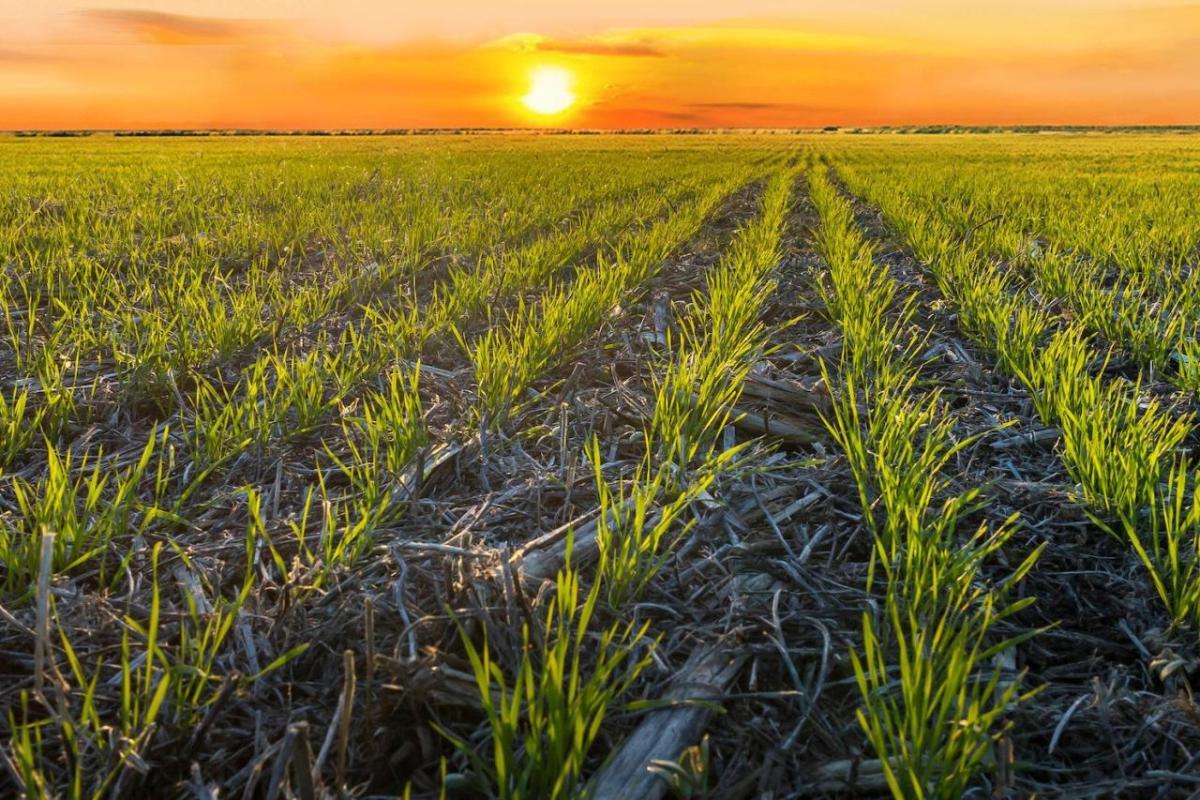(MENAFN- 3BL Media Inc) originally published by triplepundit
“Ancient wisdom meets futuristic technology” sounds like the concept for a new Hollywood blockbuster. But it's the here-and-now direction of sustainable agriculture, supporting not only the planet and its people, but also the profitability of every entity in the food production chain -from farmers to agribusinesses to brands in the consumer goods industry.
Thousands of years ago, civilizations leveraged cyclical flooding for irrigation , let the land“rest” (lay fallow) every seventh year , and used terraced farming to produce food sustainably for their people, as well as external trade and philanthropic support of the poor. In modern times, this wisdom of the ages took a back seat to mechanization and industrialization - with short-term positive output effects and long-term catastrophic ones, such as the dust bowl of the 1930s.
Over the last several decades, that same windswept stretch of country - Kansas, parts of Oklahoma and Colorado - has been among the regions reaping the benefits of sustainable agriculture, as are the companies reliant on farm products. Crop rotation, improved tillage and threshing techniques, as well as water-scarcity management advancements, make for better soil health and greater yield.
At the same time, climate change presents new challenges, such as water scarcity and increasingly severe and frequent extreme weather events. The good news is: Every region and every stakeholder in the agrarian economic system has an opportunity to be part of the global solution.
Environmental and economic solutions come together
Starting in 2013 and now operating in 14 countries, indigo ag set out to help the agriculture industry improve sustainability and profitability through the combination of science and technology - first with the use of microbes to improve soil and plant resiliency and soon adding project development and impact quantification of regenerative farming practices.
Indigo Ag's Market+ Source program in particular links up farmers, agribusinesses, and food and apparel companies to source sustainable crops and quantify impact throughout the entire supply chain.
For corporations, this program enables them to score a win in improving the accuracy of their carbon footprints and in making progress toward their climate targets; and it does so while aligning to standards such as the greenhouse gas protocol (ghgp) and science based target initiative (sbti) . Market+ Source captures the measurements corporations need to support their Scope 3 claims for marketing, investment decision-making, and evolving industry standards, while supporting farmers to employ and scale the use of the practices that deliver these results.
Meeting any of these standards is a lot like detangling a fishing line: A company has to trace and document its suppliers' practices and quantify what emissions are reduced. In agriculture, data science and technology are must-haves to accomplish this feat.
Rigorous data science, resourceful diplomacy
Jyoti Shankar, a principal data scientist at Indigo Ag, spoke with TriplePundit about both sides of the sustainable agriculture“adventure.” One is the complex data process, and the other is the human side of bringing related but separate types of companies and people together to collaborate.
on the data side , Indigo Ag avails itself of remote sensing data like satellite capture, as well as passive sensors and soil samples at farm sites, transaction and market data from various sources, and field experiments. Shankar analyzes and models the data to project the beneficial good of what is happening in the field, along the way looking for inconsistencies and missing data, so a love of sleuthing comes in handy. The data and analyses have to be scrupulously accurate to give multi-billion dollar global consumer brands the level of confidence required for use in Scope 3 emissions accounting, as Indigo Ag has been doing since 2019.
“We can simulate scenarios of potential regenerative farming practices or combinations of practices for farmers in our programs,” Shankar said.“Our goal is to determine the realistic impact of encouraging farmers to adopt more practices each year and/or increase their acreage of these practices. By managing the portfolio of practices adopted by farmers within our program, we can shape it to effectively reduce emissions and water used per unit of crop produced.”
The detective work is also needed when data comes from agribusinesses that still use manual or outdated technical systems, but it has to be coupled with a respect for the small companies that have vital information. Indigo strives for collaboration with such firms, becoming a technology provider to support their way of doing business, Shankar said.
“Scope 3 programs cannot succeed without the partnership of many supply chain partners. It's a very fragmented industry, and the data is non-trivial,” she told us.“They are folks who have been in it for a long time, who have survived the longest with the least amount of margins.
How consumer brands benefit from sustainable agriculture
With consumers now highly tuned in to climate change and other environmental issues, many have demonstrated that their purchasing dollars will go to the brands that prove their commitment to sustainability through best practices. Increasingly, investors are seeking the same . Meanwhile, extreme weather and natural resource scarcity threaten the long-term viability of agricultural supply chains - making a clear business case for companies to push climate solutions forward. Therefore, data science and technology have a central role in providing that proof.
post holdings , known for its iconic cereal, snack and pet food brands, works with Indigo to quantify the climate impact of the sustainably grown wheat used in airly crackers , a brand devoted to removing greenhouse gases. Airly is able to post its carbon reduction numbers on its website, thanks to the data Indigo provides.
“What we've seen is a real hunger from our growers for, 'What else can I do?'” said Jennifer McKnight, Airly's chief marketing officer.“With Indigo Ag, we've been bringing together world-leading scientists directly with the farmers to help answer that question. Every single year, we're getting better. The growers are learning from the scientists, the scientists are learning from the growers, and it creates that virtuous loop.”
McKnight's last comment captures a sentiment numerous members of Indigo Ag's team voiced as well: The partnership with farmers and agribusinesses is crucial.
What“tinkering” can teach us about sustainability
Shankar gets animated when talking about what Indigo Ag's data scientists learned about sustainable approaches out in Kansas fields. While Indigo Ag has a set of practices that are part of its programs, the company runs trials and pilots in partnership with farmers and various corporate brands. The successful ones become candidates for the toolbox.
Jeff Murphy, whose family has been farming in southeastern Kansas since the late 1800s, started a transition to manage the farm after graduating from Kansas State in 2015. With his management comes an interest in farming more economically while building soil health and stewarding the land. Currently 90 percent of the farm's acres of corn, beans, soybeans, wheat, and cattle are raised with practices such as reduced tillage and cover crops - two core regenerative approaches that deliver positive environmental impact.
“I really want to reduce the input costs to increase profitability, as well as improve our soil and leave the land better than I found it for future generations,” Murphy said. Last year, he experimented with a field where he applied no herbicide.“If there is a way that we could get away from these chemicals, I think it would be good for everybody.”
All of Murphy's land is dryland - meaning they do not irrigate - which can be challenging in a region that has suffered drought conditions in recent years.
To gain the benefits of natural weed suppression and increased water retention, Murphy began using cover crops three years ago on just 30 acres. He now has cover crops across 75 percent of his acres.
“The main thing I can say is, we had crops to harvest. A lot of my neighbors had zero. They had no moisture left and couldn't plant at all,” Murphy said.
Less tillage, more cover crops, fewer chemicals or lesser quantities of them - all of these translate to fewer carbon emissions and greater water conservation. Further, such natural methodologies can encourage the return of native wildlife species to revive ecosystems.
“What we notice with farmers like Jeff is that they're constantly experimenting,” Shankar said.“He's not playing with his livelihood. He's a businessman. But he's also tinkering. That tinkering is what we have to dial into.”
The data capture and analysis Indigo Ag conducts, along with its multi-pronged approach to assisting the sustainable agriculture supply chain, means less risk and greater resilience for farmers, agribusinesses, corporate brands, hungry people and animals, and a planet in need of climate relief from all quarters.
Based on these possibilities, the next "Field of Dreams" may be an entirely different movie.
learn more from indigo ag about the progress being made to make agriculture more sustainable for people and the planet.
This article series is sponsored by Indigo Ag and produced by the TriplePundit editorial team.
Image credit: Adobe Stock






















Comments
No comment